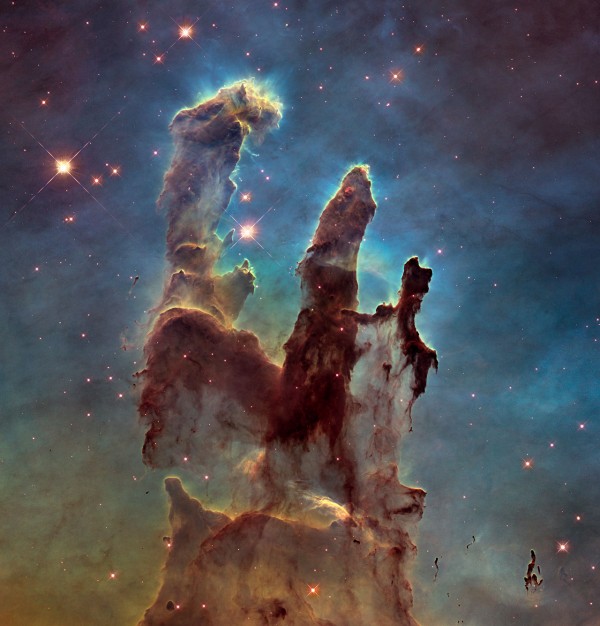
One of the most beloved images from the NASA/ESA Hubble Space Telescope is this one. It’s called the Pillars of Creation, and Hubble first captured it in 1995. Now Hubble has revisited this part of the sky, and the result is the image above: a clearer-than-ever, stunning view of the giant columns of the Pillars of Creation. Researchers presented this image and its scientific results on January 5, 2015 at the 225th meeting of the American Astronomical Society in Seattle, Washington.
The Pillars of Creation is a part of the Eagle Nebula, otherwise known as Messier 16, a region of gas and dust where new stars are forming.
In addition to the new visible-light image, above, Hubble has also produced an image of this region taken in infrared light. The infrared image, below, penetrates much of the obscuring dust and gas and unveils a less familiar view of the pillars, where newborn stars can be seen. These stars are forming within the pillars themselves.

The Hubble Space Telescope team explained more in a January 5 press release:
Although the original image was dubbed the “Pillars of Creation”, this new image hints that they are also pillars of destruction. The dust and gas in these pillars is seared by intense radiation from the young stars forming within them, and eroded by strong winds from massive nearby stars. The ghostly bluish haze around the dense edges of the pillars in the visible-light view is material that is being heated by bright young stars and evaporating away.
With these new images come better contrast and clearer views of the region. Astronomers can use these new images to study how the physical structure of the pillars is changing over time. The infrared image shows that the reason the pillars exist is because the very ends of them are dense, and they shadow the gas below them, creating the long, pillar-like structures. The gas in between the pillars has long since been blown away by the winds from a nearby star cluster.
At the top edge of the left-hand pillar, a gaseous fragment has been heated up and is flying away from the structure, highlighting the violent nature of star-forming regions.
These massive stars may be slowly destroying the pillars but they are also the reason Hubble sees the structures at all. They radiate enough ultraviolet light to illuminate the area and make the clouds of oxygen, hydrogen and sulphur glow.
Although structures like these exist throughout the universe, the Pillars of Creation — at a distance of 6500 light-years away — provide the best, and most dramatic, example. Now, these images have allowed us to see them more clearly than ever, proving that at 25 years of age, Hubble is still going strong.
Bottom line: One of the most beloved Hubble Space Telescope images is called the Pillars of Creation, first captured in 1995. Check out this new Hubble image of the pillars, made possible by the Wide Field Camera 3, installed on Hubble in 2009.
More results from this week’s AAS meeting:











